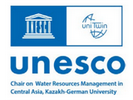



Year: 2024
Collections: Video
Topics: Water, Climate
Authors:
Countries: Kazakhstan, Uzbekistan
Source:
Year: 2024
Collections: Scientific Publications
Topics: Water, Climate
Authors: Aidar Zhumabaev, Hannah Schwedhelm, Beatrice Marti, Silvan Ragettli, Tobias Siegfried
Countries: Kazakhstan
Source: https://water-ca.org
The Badam River, a tributary to the Arys River located in the Syr Darya basin, is a crucial natural resource for ecological, social, and economic activities in the semi-arid region of southern Kazakhstan. The river basin is heavily influenced by manmade water infrastructure and faces water scarcity, particularly during summer, highlighting the importance of understanding its hydrological processes for effective water resource management. In this study, a semi-distributed conceptual hydrological model of the Badam River was implemented using the RS MINERVE hydrological software to evaluate the impacts of climate change on hydrology and to test the resilience of the water system. Connected HBV models were implemented for each of the hydrological response units that were defined as altitudinal zones. The hydrological model was calibrated using daily time steps between 1979 and 2011, and the resulting flow exceedance curves and hydrographs were used to assess the potential impacts of climate change on the basin, using CMIP6 precipitation and temperature scenarios. Future climate scenarios for the 2054 – 2064 period demonstrate that the peak discharge will be shifted to spring/late spring compared to the current early summer with no significant decrease in average discharge per day of the year. The insights gained from this hydrological-hydraulic model can be used to effectively manage the water system and inform future hydropower design decisions and serve as a blueprint for similar studies in the region and elsewhere.
Year: 2024
Collections: Scientific Publications
Topics: Water
Authors: Barakov R.Т., Sharakhmatov S.Е., Isbekov К.B., Nurtazin S.Т.
Countries: Kazakhstan
Source: https://water-ca.org/
The article presents the results of investigating the morphological variability of carp (Cyprinus carpio Linnaeus, 1758) in three large reservoirs of the Balkash-Alakol Basin – Lake Balkash, Lake Alakol, and Kapshagay Reservoir. Morphological differences in several features (counting and plasticity) were found in three carp samples. The study included the examination of 24 plastic and 14 counting features. The method of digital image processing (Morpho J) was applied to analyze the differences of the target fish species specimens by body shape. The application of the principal component analysis (PCA) method allowed determining the main loadings on the studied morphological traits of carp. The statistically reliable differences revealed allow to confirm the formation of morphological changes in carp caused by
the duration of adaptive radiation, environmental factors of water bodies and annual artificial stocking of young fish.
Year: 2024
Collections: Scientific Publications
Topics: Water, Climate, Agriculture
Authors: Nazar Nurzoda
Countries: Tajikistan
Source: https://water-ca.org/
This study aimed to examine the efficiency of different drip irrigation regimes in spring film greenhouses for early tomato harvesting. The field (small-plot) experiment included designing and testing the watering technology suitable for rural Tajikistan. Irrigation, soil moisture, and tomato growth were followed for several seasons under four irrigation pilots. The experiments showed that the most effective drip irrigation regime for Elpida hybrid tomato was carrying it out while regulating soil moisture within 75-85%, with the irrigation demand of 4,978 m3/ha and irrigation norm of 99.0 m3/ha, also contributing to better water efficiency. The volume of irrigation water for the production of one unit of tomato crop in the second experiment was 5.73 m3/ha, i.e. 14.18% less than in the control plot. The study showed that the tomato evapotranspiration coefficient tends to increase as the threshold of soil mois-ture before and after irrigation grows. The maximum net yield amounted to 1,342 thou. Somoni/ha – 1.9 times or 52.7% higher compared to the control plot. The research findings can guide individual farmers and production facilities, as well as the overall development of agrarian economies like Tajikistan.
Year: 2024
Collections: Scientific Publications
Topics: Water
Authors: Azamat Madibekov, Laura Ismukhanova, Askhat Zhadi, Botakoz Sultanbekova, Serik Zhumatayev, Alibek Karimov, Sergei Fokin
Countries: Kazakhstan
Source: https://water-ca.org
The study was conducted in 2023 and comprised a comparative assessment of the state of Lake Markakol’s aquatic ecosystems in surface and bottom water strata. The analysis of bottom water temperatures showed correlation between this parameter and dissolved oxygen concentrations, indicating that pollution caused by organic impurities leads to lake eutrophication, in turn, pro-pelling the extinction of aquatic life. Although the main water physicochemical parameters of Markakol Lake correspond to the oligotrophic type, the shifts in dissolved oxygen and phos-phate content, as well as growth of aquatic vegetation indicate its transition to the mesotrophic type. Higher phosphate content in water is a consequence of pollution disturbing the biological balance, as well as stimulating the reservoir’s eutrophication and increased biological productivity, i.e. algal bloom. In addition, phosphate ions serve an informative indicator of Hazard Class 3 (organoleptically hazardous) anthropogenic pollution. Based on the correlation factor (r), two statistical models were considered for the target lake: 1) Water Pollution: nutri-ent concentrations depending on surface and bottom water temperatures (Model 1); and 2) changes in Water Pollution Indices (biogenic, heavy metals, mean) because of air temperature growth due to global warming of 0.25°C/decade (Model 2).
For questions about cooperation, please contact us at: